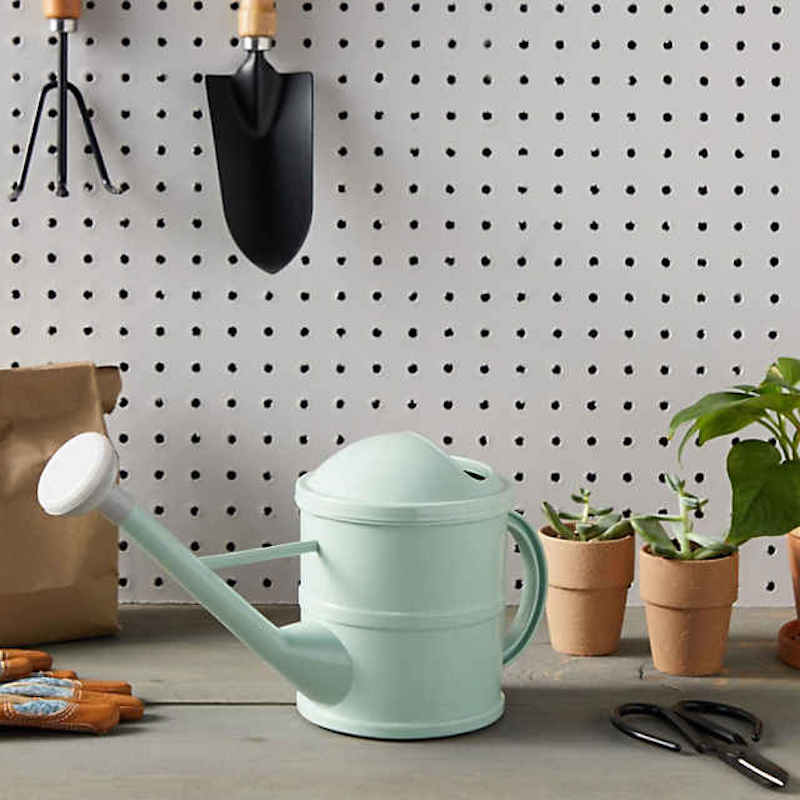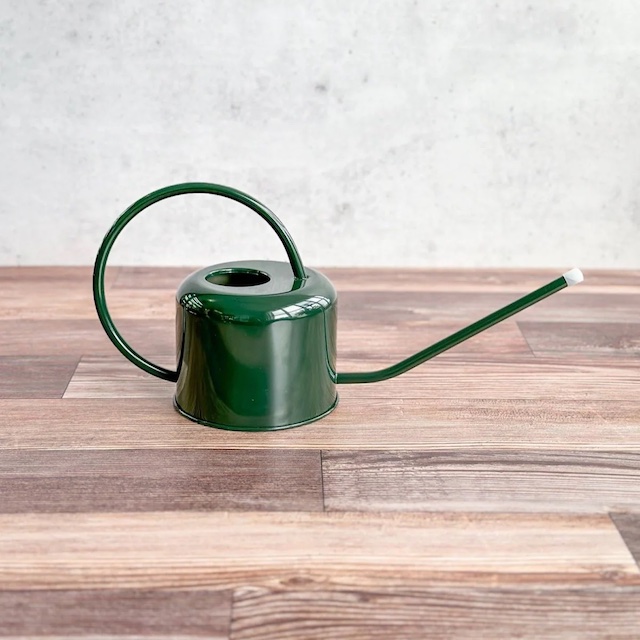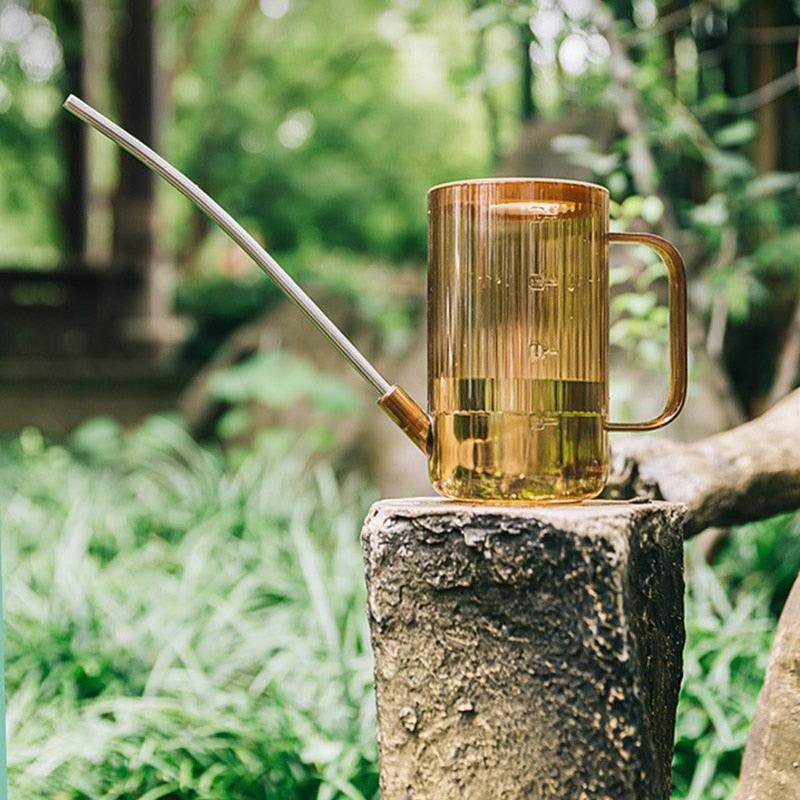
Mastering Plant Care Tips: Small Watering Can for Indoor Plants
Selecting the Right Small Watering Can for Your Indoor Plants
Choosing the right small watering can for your indoor plants is crucial. You need a can that fits your hand comfortably and reaches your plants with ease. Look for designs that complement your indoor space. A can with a long spout helps target water exactly where it’s needed. Consider the material too – plastic, metal, or ceramic are common. Each has its pros and cons. Plastic cans are lightweight and cheap, but may not last as long. Metal cans are durable, though they can be heavier. Ceramic cans look great, but they can be fragile and pricey. Pick a size that holds enough water for all your plants, without refilling too often. A smaller can prevent over-watering, a common mistake. Remember, a small watering can for indoor plants should be practical and fit your watering habits well.
Key Features to Look for in a Small Watering Can
When shopping for a small watering can for indoor plants, certain key features can make all the difference in ease of use and plant health. Here are the features to prioritize:
- Ergonomic Design: Choose a can with a comfortable grip that reduces hand strain. An ergonomic handle is essential for regular use.
- Long Spout: A long and narrow spout allows for precision watering, reaching the soil rather than the leaves which can help prevent diseases.
- Material Quality: Opt for materials that balance durability and weight. Metal is sturdy, while plastic is light. Pick based on your preference and the can’s longevity.
- Volume Capacity: Consider the amount of water it holds. It should be enough to water all your plants without the need for constant refills.
- Detachable Rose: Some cans come with a detachable rose (the sprinkling head), which is useful for gentle watering of delicate plants.
- Balance and Control: A well-balanced can gives better control over the water flow, preventing spills and over-watering.
- Aesthetic Appeal: While functionality is key, a can with a design that complements your living space adds to the indoor aesthetic.
Look for these features to ensure your small watering can is not only functional but also a joy to use for your indoor gardening tasks.
The Importance of Watering Frequency for Indoor Plants
Getting the watering frequency right is key to the health of indoor plants. Each plant has unique needs. Some thrive on moisture, while others need dry soil between watering. Finding the right balance is crucial. Too much water leads to root rot and pest issues. Too little, and your plants may wilt and lose vigor. Use a small watering can for indoor plants to control the amount of water. This prevents the common problem of over-watering. Check the soil moisture before watering. If it’s damp, wait. If dry, it’s time to water. Stick to a routine to ensure regular care. Pay attention to changing seasons as well. Plants often need less water in winter. Adjust your watering schedule to suit these cycles. In summary, a proper watering frequency keeps plants healthy and strong. It’s a simple yet vital part of indoor plant care.
Best Practices for Watering Indoor Plants with a Small Can
When watering indoor plants, some best practices can help ensure your plants receive the right amount of water without causing harm. Here are some tips to get you started:
- Check The Soil: Before watering, always check the soil’s moisture. Use your finger or a moisture meter.
- Water Evenly: Ensure the water covers all the soil surface, not just one side. This helps roots grow evenly.
- Use Room Temperature Water: Cold water can shock plant roots. Let tap water sit until it reaches room temperature.
- Morning Watering: Water plants in the morning. This gives them time to absorb water before nightfall.
- Avoid Wet Leaves: Direct water at the soil to prevent leaf diseases. A small can with a long spout is perfect for this.
- Drain Excess Water: After watering, let excess water drain away. Plants shouldn’t sit in water.
- Regular Cleaning: Keep your small watering can clean. Residue can clog the spout and introduce bacteria to your plants.
- Adapt to Seasons: Watering needs change with seasons. Plants typically need less water in cooler months.
By following these simple best practices when using a small watering can for indoor plants, you’ll promote healthier growth and avoid common watering pitfalls.
Maintaining Your Small Watering Can for Longevity
Caring for your small watering can for indoor plants is key to its longevity. Here’s how to do it:
- Regular Cleaning: Empty and rinse after each use. This prevents algae and mineral buildup.
- Proper Storage: Keep your can indoors to protect from weather. This prevents rust and damage.
- Inspect Regularly: Check for leaks or clogs. Fix issues promptly to maintain function.
- Gentle Use: Handle your can with care. Avoid dropping it, especially if it’s made of ceramic.
- Avoid Sunlight: Store out of direct sunlight. Sun can weaken plastic over time.
- Rust Prevention: For metal cans, dry after use. This keeps rust at bay.
Following these tips will help ensure your small watering can for indoor plants stands the test of time, making plant care a smoother process.
Common Mistakes to Avoid When Watering Indoor Plants
Using a small watering can for indoor plants is a smart choice. But even with the right can, common mistakes can harm your plants. To keep plants thriving, be aware of these errors:
- Overwatering: This is the most frequent mistake. Soil should feel dry before you water again. Overwatered plants fall prey to root rot.
- Ignoring Signs: Plants signal their needs. Drooping, yellowing, or dry leaves mean it’s time to reassess your watering routine.
- Using Cold Water: Cold water shocks roots. Always use water at room temperature to avoid this shock.
- Uneven Watering: Water should reach all parts of the soil. A long spout on your can helps with even distribution.
- Watering at Night: It’s best to water in the morning. Night watering can lead to fungal growth due to lower evaporation rates.
- Forgetting Seasonal Changes: Plants often need less water in cooler months. Adjust your watering habits with the seasons.
- Not Cleaning the Can: Leftover water and debris in the can can breed bacteria. Clean after use to keep things fresh.
Steer clear of these watering missteps to keep your indoor garden healthy. The right practices make all the difference.
Creative Ideas for DIY Small Watering Cans
Making your own small watering can for indoor plants can be fun and rewarding. Here are some creative DIY ideas:
- Recycled Containers: Turn old bottles or jugs into watering cans. Clean them, then poke holes in the lids for a sprinkling effect.
- Canned Good Transformation: Empty cans can work too. Clean a large can, nail holes in the bottom, and attach a handle.
- Milk Jug Makeover: A milk jug with a punctured cap makes a great large-capacity watering can. Add a handle for ease.
- Teapot Repurposing: An old teapot can be a quaint watering can. It’s perfect for delicate watering with its built-in spout.
- PVC Pipe Method: Construct a can from PVC pipes. Fit with a cap and drill holes for a custom sprinkle pattern.
- Squeeze Bottle Solution: A clean squeeze bottle, like a ketchup bottle, lets you control water flow easily. Just fill and use.
- Spray Bottle Watering: For fine mists, use a spray bottle. This is ideal for plants that prefer a gentle touch.
- Wooden Box Can: Craft a wooden box with a handle and a spout for a rustic look. Seal it properly to hold water.
Remember, when you make a DIY small watering can, ensure it’s easy to fill, carry, and pour. Always test it to make sure it works as expected before using it on your plants.
Tips for Eco-Friendly Watering Practices with Small Cans
Being eco-friendly is important for both the planet and your plants. When using a small watering can for indoor plants, you can adopt several green practices. Here are some tips to help you water your plants in a sustainable way:
- Reuse Water: Collect rainwater or reuse water from household tasks, like rinsing fruits and vegetables, to water your plants.
- Water Conservation: Only water your plants when necessary. Over-watering not only harms the plants but also wastes water. Checking the soil’s moisture can help you water only when required.
- Eco-Friendly Materials: Choose watering cans made from recycled materials or sustainable sources. This reduces your carbon footprint.
- Local Plants: Opt for plants that are native to your area. They usually require less water and are better adapted to the local climate.
- Mulching: Apply organic mulch to your plant’s soil. It helps retain moisture and reduces the need to water frequently.
- Drip Irrigation: For larger indoor plant collections, consider a drip irrigation system from a reused container to minimize water usage.
- Scheduled Watering: Stick to a watering schedule that aligns with the natural needs of your plants. This ensures you’re not giving more water than necessary.
By following these straightforward eco-friendly practices with your small watering can for indoor plants, you’re not only saving water but also ensuring the health of your beloved green companions.
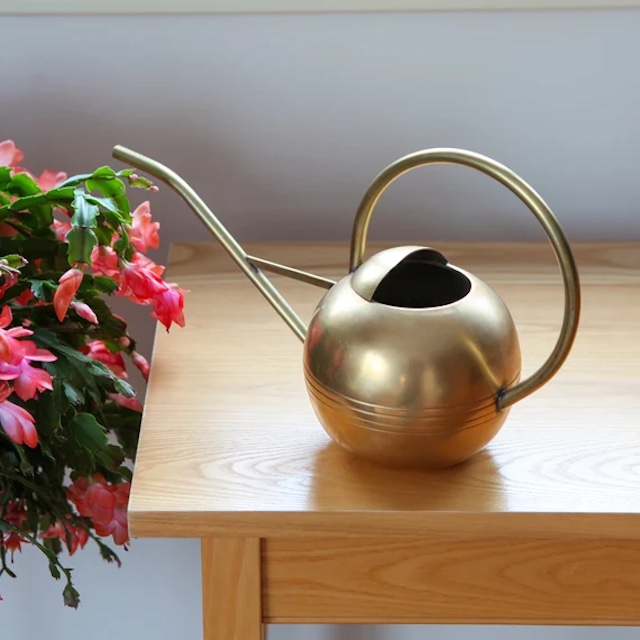
Outdoor Gardening: Essentials of Brass Watering Can Care
The Benefits of Using a Brass Watering Can
Choosing a brass watering can for your gardening tasks comes with a variety of benefits. Not only does its charming aesthetic appeal add a touch of elegance to your gardening toolkit, but brass watering cans also offer practical advantages.
Firstly, brass is a robust material known for its durability. This means that a brass watering can is likely to last longer than cans made from other materials, ensuring value for money in the long run.
Another benefit is the natural resistance of brass to rust. Watering cans are regularly exposed to moisture, so having one that won’t rust easily is a significant plus. This feature reduces maintenance hassles and also keeps the water cleaner.
Brass watering cans also tend to have superior balance and control, which stems from their quality construction. This makes watering plants more precise, avoiding water waste and ensuring that water goes exactly where it’s needed – to the roots of your plants.
The heft of a brass watering can provides another hidden advantage. It offers a stable heft that resists tipping over in windy conditions, which can be particularly useful for outdoor gardening.
Finally, brass watering cans are often considered works of art in themselves. Their classic design makes them a stylish accessory that can enhance the overall aesthetic of your garden or home.
In summary, opting for a brass watering can can offer longevity, rust resistance, precision in watering, stability, and a touch of style to your gardening practice. These benefits combine to not only make your gardening more effective but also more enjoyable.
Key Features to Look for in a Quality Brass Watering Can
When choosing a brass watering can, several key features ensure its quality and functionality. Look for these essentials to make sure you get the most out of your investment:
- Durability: The brass should be thick and solid to withstand frequent use and potential impacts. A sturdy construction means your can will last many seasons.
- Ergonomic Design: A well-designed handle and spout provide comfort and ease during use. It should feel balanced in your hand and pour water smoothly.
- Corrosion Resistance: High-quality brass should resist corrosion. Check for a clear protective coating that will keep the can looking new for longer.
- Capacity: Consider how much water you need. A larger capacity means fewer trips to refill, but it should not be so heavy that it’s hard to carry.
- Aesthetics: Choose a design that complements your garden. A polished finish or decorative details can add beauty to the utilitarian object.
- Balance: The can should not tip over when set down. A stable base and the right weight distribution are important for ease of use.
- Spout Length: Look for a spout that is long enough to reach your plants without straining. A detachable or adjustable spout can be a bonus.
Selecting a brass watering can with these features will ensure it is not only a practical tool for your gardening but also a lasting part of your gardening ensemble.
Step-by-Step Guide to Cleaning Your Brass Watering Can
To keep your brass watering can in top condition, regular cleaning is essential. Here’s a simple, step-by-step guide to help you maintain the luster and functionality of your brass watering can:
- Empty the Can: Ensure it is completely empty of water to prevent diluting the cleaning solution.
- Prepare a Cleaning Solution: Mix warm water with a gentle dish soap. Avoid harsh chemicals that can damage brass.
- Scrub Gently: Use a soft cloth or sponge to wipe the surface. Scrub inside and out to remove dirt and grime.
- Rinse Thoroughly: After scrubbing, rinse the can with clean water. Make sure no soap residue remains.
- Dry Completely: Use a soft towel to dry the watering can. Ensure it’s completely dry to prevent water spots.
- Polish if Needed: If your can has lost its shine, use a brass polisher. Apply a small amount and rub it in with a soft cloth.
- Wipe with a Dry Cloth: Finish by buffing with a clean, dry cloth for a gleaming surface.
- Reassemble the Can: If your can has a detachable spout, put it back together carefully.
By following these simple steps, you’ll help your brass watering can resist tarnish and maintain its beauty. Regular cleaning not only maintains appearances but also ensures that your gardening tool performs well for years to come. Use the brass watering can with care, and it will remain a functional and stylish part of your gardening routine.
Preventing Tarnish and Corrosion on Brass Watering Cans
Keeping your brass watering can tarnish and corrosion-free is important. Simple steps can ensure its longevity. Here’s how to prevent these issues:
- Keep It Dry: Always empty your brass watering can after use. Water residue can lead to tarnish and corrosion. Wipe it down with a soft cloth to remove any remaining moisture.
- Store Correctly: Do not leave your brass watering can outside. Exposure to the elements can cause tarnishing. Store it in a dry, sheltered place when not in use.
- Use Natural Cleaners: For regular cleaning, avoid harsh chemicals. They can strip away protective layers. Use lemon juice and baking soda for a gentle, natural clean. Apply with a soft cloth, then rinse and dry.
- Regular Polishing: Lightly polish your brass watering can with a suitable brass polish. This adds a protective layer to prevent tarnish. Do this every few months, or as needed.
- Avoid Dents and Scratches: Treat your brass watering can with care. Dents and scratches can damage the surface. This damage makes it easier for tarnish and corrosion to take hold.
- Monitor for Signs of Wear: Inspect your can regularly. Look for any changes in color or small spots. These can signal the start of tarnish and corrosion. Take action early to clean and protect the area.
By following these tips, your brass watering can will remain a beautiful and functional tool in your garden.
Storing Your Brass Watering Can to Prolong Its Life
Proper storage is key to extending the life of your brass watering can. Here are some tips to ensure it remains in the best condition:
- Pick a Dry Location: Store your can in a dry place. Moisture can cause tarnish and corrosion.
- Avoid Direct Sunlight: Keep your can away from direct sunlight. Sun can heat the brass and cause discoloration.
- Use a Protective Cover: Consider a cloth cover to keep dust and dirt away.
- Keep It Elevated: Place your can on a shelf or in a cabinet. This avoids direct contact with damp floors.
- Use Pads or Liners: If you must store it on the ground, use rubber pads or liners for protection.
- Avoid Stacking: Do not pile items on or around the can. This can cause scratches and dents.
- Store Empty: Make sure your watering can is empty before storing. This prevents water from stale.
Storing your brass watering can with care will make it last longer and stay bright and functional.
Common Issues and Troubleshooting for Brass Watering Cans
Even with meticulous care, your brass watering can may face some common issues. Understanding these can help you troubleshoot effectively.
- Leaks: If you notice water leaking, check the seams and joints. Apply a sealant or solder to repair minor leaks.
- Clogged Spout: A blocked spout can hinder watering. Clear any debris with a thin wire or by running water through it.
- Discoloration: Brass can discolor over time. Clean it with a mix of lemon juice and baking soda to restore its color.
- Dents: Small dents can often be smoothed out. Gently tap the dented area with a soft mallet from the inside.
- Loose Handle: Tighten any screws on the handle. If it’s soldered, a professional may need to reattach it.
- Corrosion: Corrosion spots may appear. Clean them with a brass polish and protect the area from moisture.
- Calcium Build-Up: Hard water can leave calcium deposits. Use vinegar to dissolve the build-up, then rinse well.
By addressing these issues promptly, you can keep your brass watering can in working order. Regular checks and maintenance will help you avoid many of these problems.
Enhancing Your Gardening Experience with a Well-Maintained Brass Watering Can
Caring for your brass watering can not only prolongs its life but also enhances your gardening experience. Here are some ways to keep your can in great shape for an enjoyable gardening routine:
- Inspect Regularly: Check your brass watering can often for any signs of damage or wear. Catching issues early on can prevent bigger problems later.
- Gentle Use: When watering, handle your can with care. Avoid dragging it across hard surfaces or knocking it against objects.
- Balance Watering Loads: Don’t overfill to prevent heavy lifting. This keeps you comfortable and the can in good condition.
- Proper Post-Use: After watering, empty the can entirely. Then wipe it down to eliminate any moisture that can cause issues.
- Mindful Placement: Place your can gently on surfaces. Dropping or tossing it might dent or damage the brass.
- Efficient Watering: Ensure you water plants at their base. This saves water and targets the roots. Your brass watering can’s design aids in this precise watering.
Following these tips ensures a positive gardening experience. A well-maintained brass watering can is reliable, easy to use, and a delight to own. It makes gardening tasks less of a chore and more of a peaceful hobby.
Creative Ways to Display Your Brass Watering Can When Not in Use
When not in use, your brass watering can is more than just a tool. It’s a piece of decor that can add charm to any room or garden space. Here are some creative ideas to display your can elegantly:
- In the Garden: Use it as a centerpiece. Place your brass watering can amid your flowers. It will shine in the natural light and show off its design.
- On Shelves: Display it on a shelf. Surround it with potted plants or gardening books. This elevates the can to an art piece.
- Near the Entrance: Make it a welcome sight. Set it by your front door. It can hold fresh flowers and greet guests.
- With Garden Tools: Create a tool arrangement. Group your brass watering can with other gardening tools. This can turn a utilitarian space into a charming nook.
- As Kitchen Decor: Include it in the kitchen. A brass watering can can hold cooking utensils or just sit prettily on a counter.
- In the Living Area: Position it in a living space. Place it on a mantelpiece or coffee table. It brings a touch of the outdoors inside.
- Hanging Up: Use hooks to hang your can. This keeps it off the ground and can fill empty wall space beautifully.
Remember, when displaying your brass watering can, keep it away from moisture and direct sunlight to prevent tarnish. A well-placed can is not only a practical watering tool but also a statement piece that reflects your style and love for gardening.
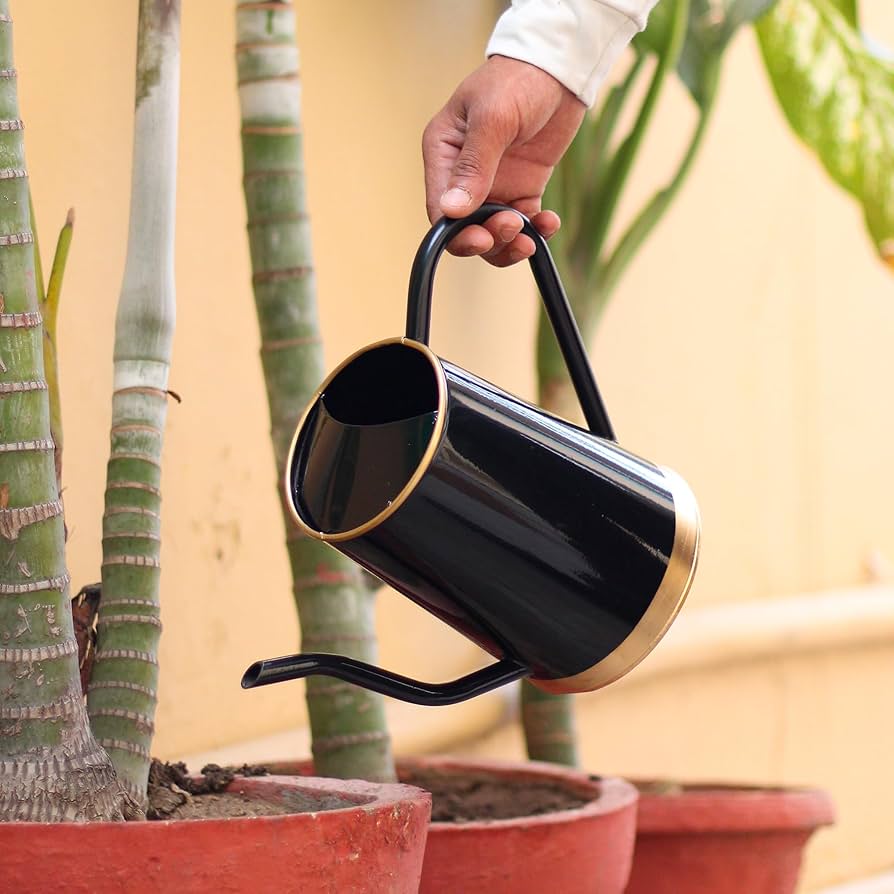
Garden Watering Can Choices: Choosing the Smart Watering Can
The Importance of Choosing the Right Watering Can
Choosing the right garden watering can is crucial for any gardener. It can mean the difference between thriving plants and a struggling garden. A good can makes watering easier, more efficient, and can help in controlling the amount of water your plants receive. The right can should suit the size of your garden and the types of plants you care for.
Here’s why finding the right watering can is so important:
- Consistent Watering: A well-designed can allows for even distribution of water, which is essential for plant health.
- Ease of Use: A can that’s easy to carry and pour will make your gardening tasks less straining.
- Water Control: The best cans offer control over the water flow, preventing over-watering or under-watering.
- Longevity: Quality cans last longer, so they’re a better investment in the long term.
- Plant Health: The right can helps in preventing diseases by not allowing water to splash on the leaves, which can lead to fungal diseases.
When searching for the perfect garden watering can, keep these points in mind to ensure your garden flourishes. A smart choice now can save a lot of trouble for your garden in the future.
Types of Garden Watering Cans
When selecting a garden watering can, understanding the different types available is key.
- Standard Watering Cans: These are the typical cans you may think of first. They come with a single handle and a spout and are great for general use.
- Long-Spout Watering Cans: With a longer spout, these cans offer more reach and control, making them perfect for watering plants farther away or in tight spaces.
- Watering Cans with a Rose Attachment: The rose, a detachable perforated nozzle, creates a gentle shower of water ideal for delicate plants and seedlings.
- Children’s Watering Cans: Smaller in size and often colorful, these cans are designed for kids to handle and use easily, helping them learn about gardening.
- Professional Watering Cans: For the avid gardener, professional cans may come with multiple attachments and adjustable spouts for various watering needs.
By considering the type of watering tasks you have and the plants in your care, you can choose a garden watering can that’s right for your gardening activities.
Material Matters: Plastic vs Metal Watering Cans
When choosing a garden watering can, the material is a critical aspect to consider. Both plastic and metal cans have their own advantages and drawbacks that cater to different gardening needs. Here’s a quick comparison:
Plastic Watering Cans:
- Lightweight: They are easier to carry when full.
- Affordable: Generally cost less than metal options.
- Weather-resistant: Do not rust or corrode over time.
- Variety of Designs: Come in many colors and shapes.
- Less Durable: May crack or fade with exposure to sunlight and temperature changes.
Metal Watering Cans:
- Sturdy: Often last longer than plastic ones.
- Weighty: Provide a stable pour, but can be heavy when full.
- Classic Look: Offer a traditional aesthetic for your garden.
- Prone to Rust: Require more care to prevent rusting.
- Costlier: Usually more expensive due to durability and style.
Your choice should depend on how often you use the can, the amount of water needed for your plants, and your budget. Also, consider if you’ll be leaving the can outdoors where it could be affected by weather. For those who enjoy style as well as function, a metal can might be worth the investment. If you prioritize function and price, plastic may be the way to go. Always weigh the pros and cons for your specific situation before making your final decision.
Size and Capacity: Finding the Best Fit for Your Garden
When selecting a garden watering can, the size and capacity are crucial to consider. Here are key points to help you find the best fit for your garden needs:
- Garden Size: For large gardens, choose a larger capacity can to avoid frequent refills. A can that holds more than 2 gallons is ideal. For small gardens or indoor plants, a smaller can, perhaps under 1 gallon, will do.
- Plant Needs: Some plants require more water than others. Adjust the can size to match the water demand of your plants.
- Weight When Full: Remember, water is heavy. A full gallon weighs over 8 pounds. Make sure you can comfortably carry and pour from the can when it’s full.
- Manageable Size: Even if you have a large garden, ensure the can is not too bulky for you to handle. It should be easy to maneuver between plants.
- Storage Space: Consider how much room you have to store your watering can. Choose a size that fits your storage area well.
Finding the right size and capacity for your garden watering can ensures efficiency and ease in your gardening routine. Keep these factors in mind and your garden, as well as your back, will thank you.
Features to Look For in a Smart Watering Can
When picking a garden watering can, consider these smart features:
- Adjustable Flow: Look for cans with adjustable spouts. These let you control water flow to suit different plants.
- Measurement Markings: Some cans include markings. They help you give the precise amount of water your plants need.
- Comfortable Grip: A can with a good grip makes watering less tiring. Your hand will feel better after gardening.
- Balance: A well-balanced can make it easier to carry and pour. You’ll avoid spilling water.
- Durability: Pick cans that will last. Long-lasting materials save money over time.
- Removable Rose: Cans with this feature allow a gentle water flow. It’s perfect for watering without harming plants.
A can with these features will help your garden. It makes watering simple, effective, and enjoyable. Choose smart and your garden will show the benefits.
Ergonomic Design: Comfort While Watering
Selecting a garden watering can with an ergonomic design is essential for comfort. Ergonomics focus on the user’s ease and efficiency in their work environment. For gardening, that means finding tools that minimize strain and enhance the watering process. Here are features of an ergonomically designed watering can that ensure comfort while watering your garden:
- Lightweight Material: Choose a can made of lightweight material. It should be easy to lift and carry.
- Curved Handle: A handle that curves can distribute weight evenly. This design reduces wrist strain.
- Easy-Tilt Feature: Some cans have a design that makes tilting to pour simple. Look for this feature to avoid awkward angles.
- Non-Slip Grip: A grip that prevents slipping is crucial. It ensures secure handling and less effort.
When watering, the right can feels like an extension of your arm. It should not cause pain or discomfort. The best ergonomic watering cans help you water your garden without the extra physical stress. Remember, a comfortable gardener is likely to maintain a healthy, beautiful garden.
Innovative Watering Can Accessories and Attachments
Gardeners know that sometimes the smallest tweaks make the biggest difference. Your garden watering can could do so much more with the right accessories and attachments. These innovative extras add versatility and precision to your watering routine.
- Water Level Indicators: Never guess how much water is left. Indicators show the water level at a glance.
- Interchangeable Spouts: Switch between spouts for different plants. From a fine mist to a steady stream, get the right water flow.
- Extension Wands: Reach plants in the back without strain. Wands add length to your can’s spout.
- Pump Action: Some attachments let you apply pressure. This gives a continuous spray without constant tipping.
- Filter Screens: They keep debris from clogging the spout. Clean water flows out, keeping your plants happy.
These add-ons make your gardening tools work smarter, not harder. With them, your watering can becomes more than just a container. It evolves into a precision tool that caters to the diverse needs of your garden. Remember to choose accessories that match the make and model of your can for the best fit.
Tips for Maintaining Your Garden Watering Can
Maintaining your garden watering can is key to its longevity and functionality. Here are some practical tips:
- Regular Cleaning: Rinse your can after each use to prevent dirt build-up. Clean it with mild detergent occasionally.
- Proper Storage: Keep your can in a dry place to avoid rust and sunlight damage. This applies especially to metal cans.
- Inspect for Damage: Check for leaks, cracks, or rust regularly. Fix small issues before they become bigger problems.
- Handle With Care: Treat your can gently to avoid dents and damages. Don’t drop it or throw it around.
- Empty After Use: Always empty leftover water. This prevents algae growth and reduces excess weight that could deform your can.
With these simple care steps, your garden watering can will stay in great shape, making your gardening easier and more pleasurable.
